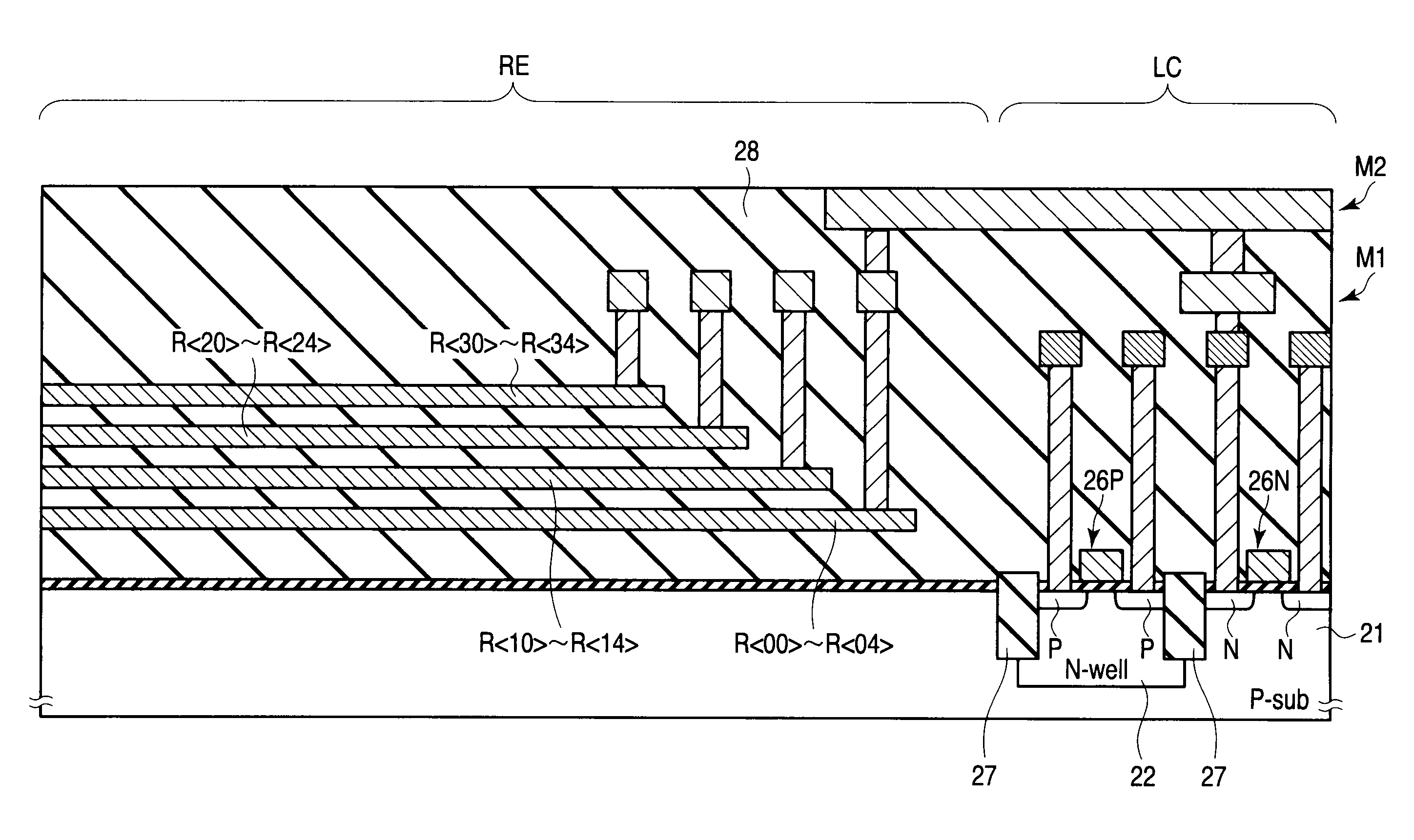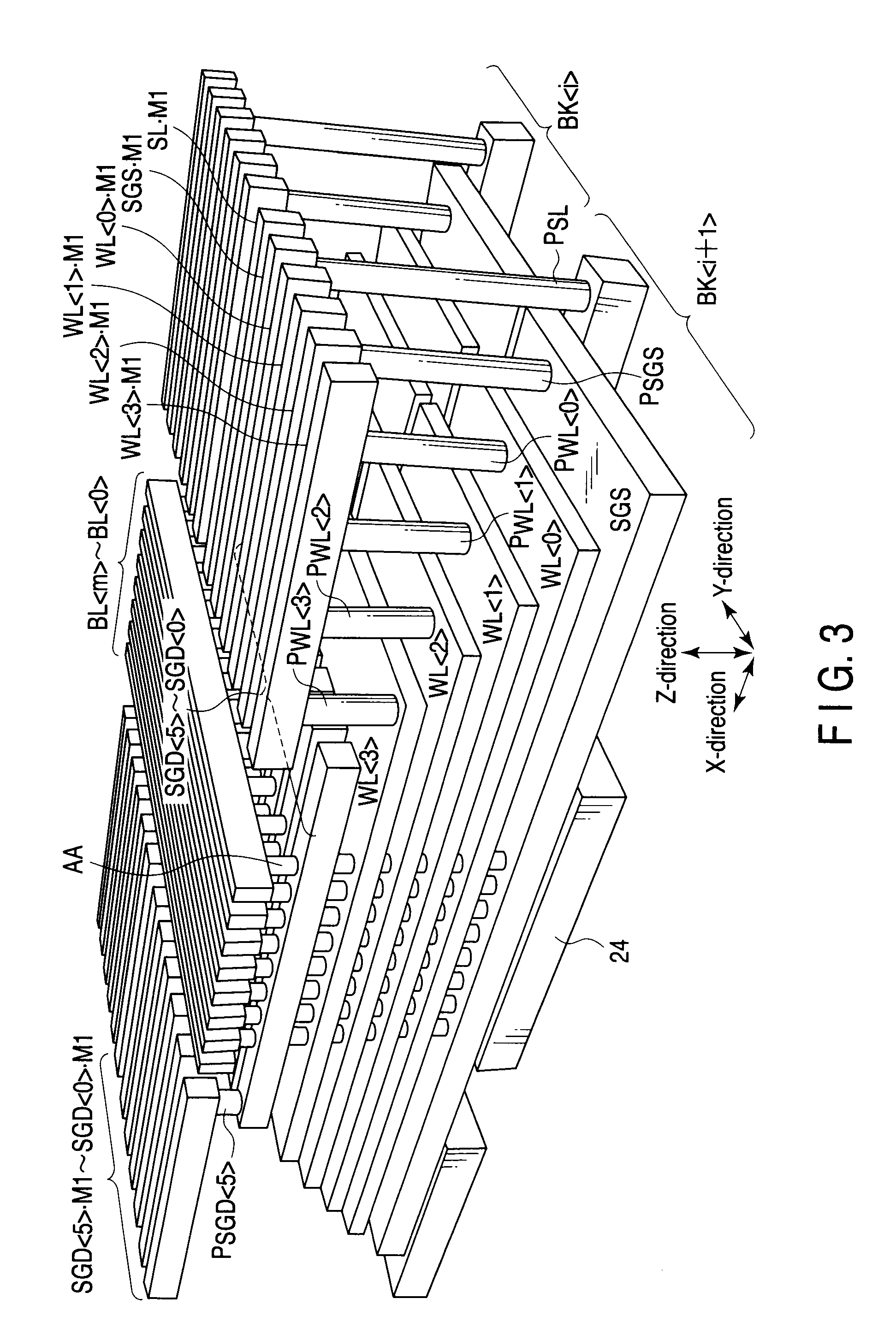Semiconductor device
a technology of resistor element and capacitance element, which is applied in the direction of semiconductor devices, digital storage, instruments, etc., can solve the problem of not sufficiently studying the 3-dimensional peripheral circui
- Summary
- Abstract
- Description
- Claims
- Application Information
AI Technical Summary
Benefits of technology
Problems solved by technology
Method used
Image
Examples
fourth example
(4) Fourth Example
[0294]FIG. 53 shows a resistance element according to a fourth example of the invention. FIG. 53A is a plan view of the semiconductor substrate, and FIG. 53B shows an equivalent circuit of FIG. 53A.
[0295]In the fourth example, it is assumed that the number of stacked conductive layers is set to four and the number of conductive lines in each conductive layer is set to two. The two conductive lines in each conductive layer are made of conductive polysilicon.
[0296]The two conductive lines in each conductive layer are extended in the first direction. Preferably the conductive lines are disposed with a constant pitch in a second direction, and the widths in the second direction of the two conductive lines are equally set. The length in the first direction of the conductive line is gradually shortened from the lowermost layer toward the uppermost layer. That is, both ends of the four conductive layers have stairsteps respectively.
[0297]In the fourth example, because the...
fifth example
(5) Fifth Example
[0299]FIG. 54 shows a resistance element according to a fifth example of the invention. FIG. 54A is a plan view of the semiconductor substrate, and FIG. 54B shows an equivalent circuit of FIG. 54A.
[0300]In the fifth example, it is assumed that the number of stacked conductive layers is set to three and the number of conductive lines in each conductive layer is set to one. The one conductive line in each conductive layer is made of conductive polysilicon.
[0301]The one conductive line in each conductive layer is extended in the first direction. The length in the first direction of the conductive line is gradually shortened from the lowermost layer toward the uppermost layer. That is, both ends of the four conductive layers have stairsteps respectively.
[0302]In the fifth example, because the number of stacked layers is the odd number (three layers), the terminal A of the 3-dimensional-structure resistance element is drawn from one end side of the four conductive layers...
sixth example
(6) Sixth Example
[0304]FIG. 55 shows a resistance element according to a sixth example of the invention. FIG. 55A is a plan view of the semiconductor substrate, and FIG. 55B shows an equivalent circuit of FIG. 55A.
[0305]In the sixth example, it is assumed that the number of stacked conductive layers is set to three and the number of conductive lines in each conductive layer is set to two. The two conductive lines in each conductive layer are made of conductive polysilicon.
[0306]The two conductive lines in each conductive layer are extended in the first direction. Preferably the conductive lines are disposed at constant intervals in the second direction, and the widths in the second direction of the two conductive lines are equally set. The length in the first direction of the conductive line is gradually shortened from the lowermost layer toward the uppermost layer. That is, both ends of the four conductive layers have stairsteps respectively.
[0307]In the sixth example, because the ...
PUM
 Login to View More
Login to View More Abstract
Description
Claims
Application Information
 Login to View More
Login to View More - R&D
- Intellectual Property
- Life Sciences
- Materials
- Tech Scout
- Unparalleled Data Quality
- Higher Quality Content
- 60% Fewer Hallucinations
Browse by: Latest US Patents, China's latest patents, Technical Efficacy Thesaurus, Application Domain, Technology Topic, Popular Technical Reports.
© 2025 PatSnap. All rights reserved.Legal|Privacy policy|Modern Slavery Act Transparency Statement|Sitemap|About US| Contact US: help@patsnap.com



